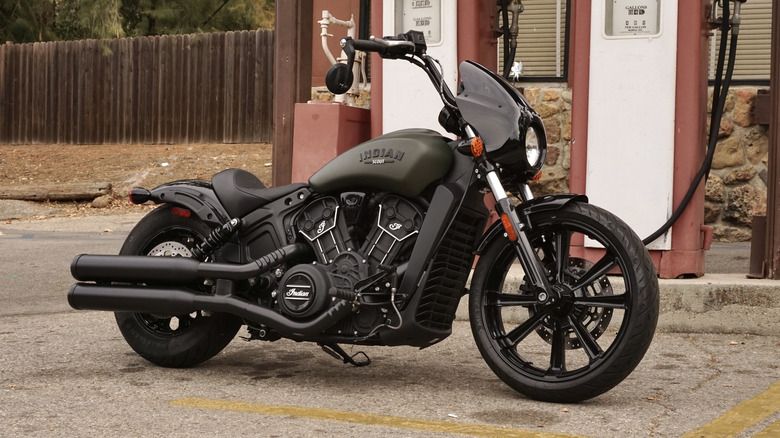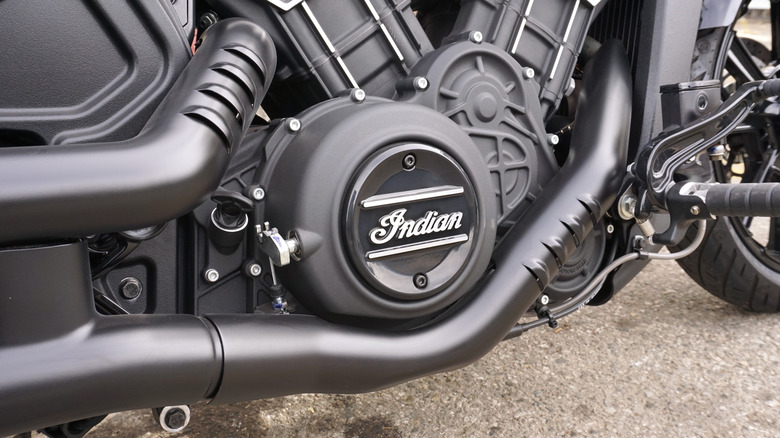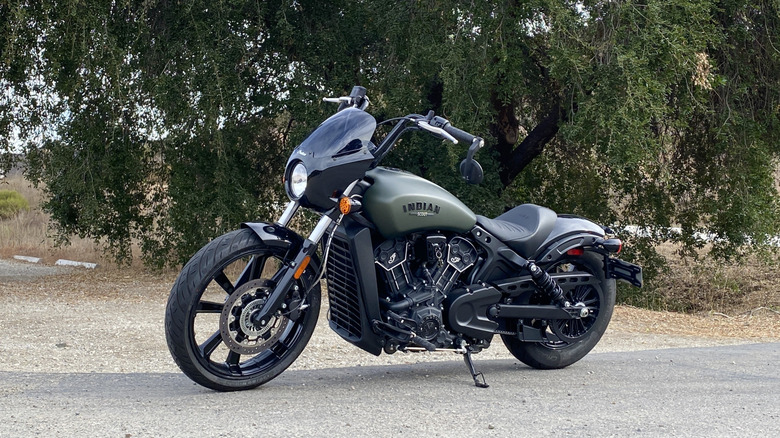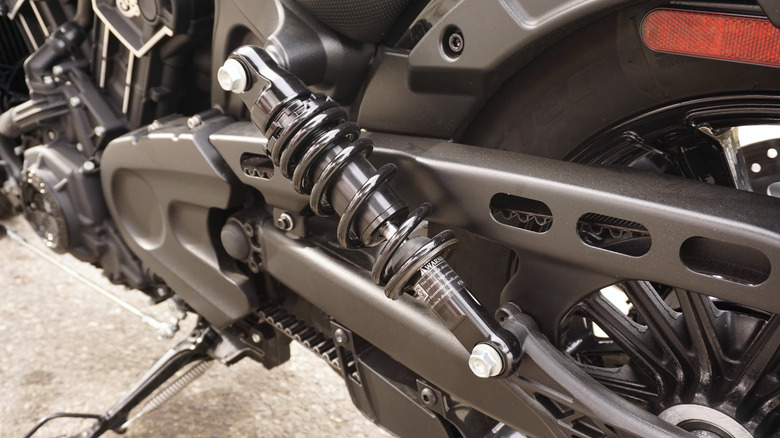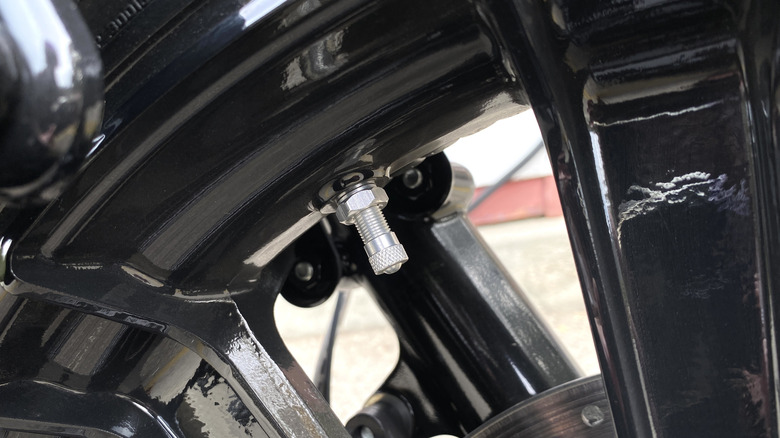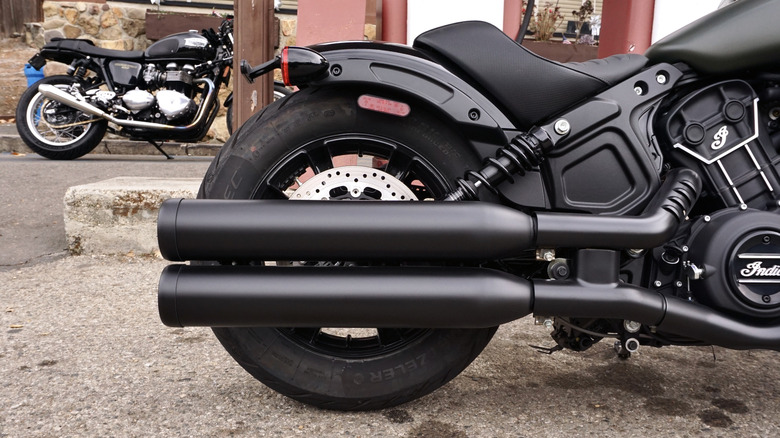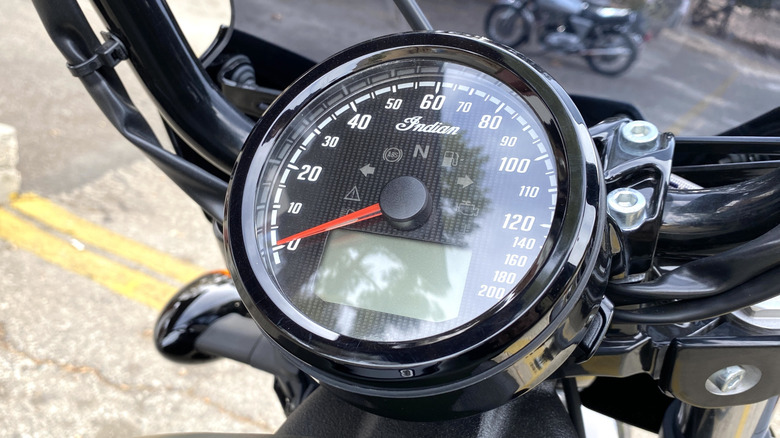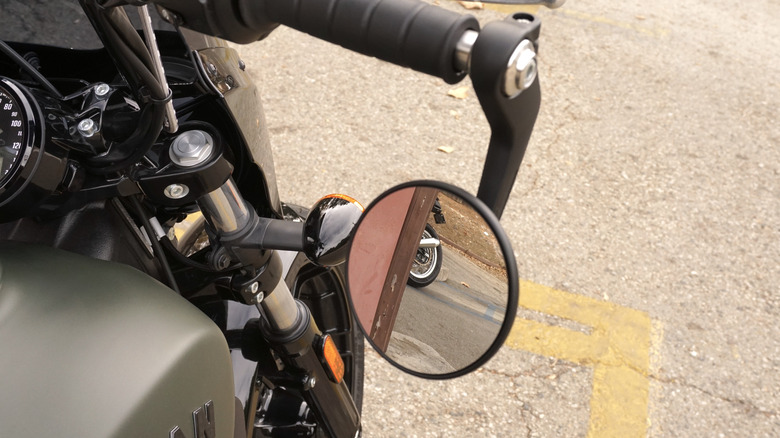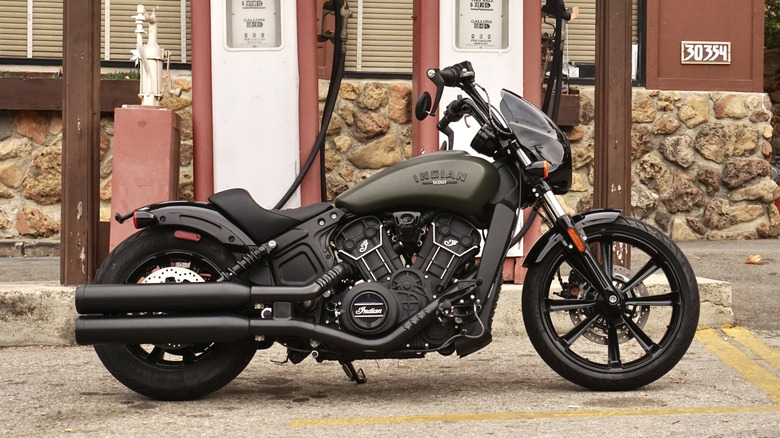As The 2024 Indian Scout Rogue Replacement Nears, Here's What We'll Miss The Most
- Looks and sounds like a proper cruiser
- Good upright seating position
- Strong top-end power
- Extremely stiff rear suspension
- Foot pegs drag easily
- Uninspiring low-end grunt
The current generation of the Indian Scout is on its way out, leaving the American motorcycle manufacturer's lineup to make space for an all-new model. The new 2025 Indian Scout is arriving soon and we've already had a close-up look to see what it's all about, but Indian wanted me to take the 2024 Scout Rogue for a ride before it's too late.
My regular rides are sport bikes. Between my two-car parking spot allotment at home, I've got a Honda CBR600RR and a Yamaha XSR900. They're both fast and fun in their own ways, but neither provides the same kind of vibes as this low-slung cruiser. So, even though it wasn't the newest and freshest model in the lineup, I happily took delivery of the Scout Rogue. Geared up, I left my corner-carving Japanese bikes locked up at home and took the Scout Rogue up the coast, over the mountains, and through the gauntlet that is Los Angeles traffic.
Plenty of power for the package
According to Indian, the Scout Rogue checks in at 545 pounds with fluids. That weight, while significant compared to something like a sport bike, is still scant enough to make the Scout Rogue feel relatively light on its feet. It's easy enough to push around parking lots and maneuver into tight spaces. With 100 horsepower and 72 lb-ft of torque on tap, the Scout Rogue's forward thrust is more than enough to push you up against the back of the seat. The power band from the 69 cubic-inch (1,133cc) 60-degree V-Twin, however, is higher in the rev range than I'd expect from a bike of this size.
Low in the rev range, the Scout Rogue feels like me: a bit lazy before my first cup of coffee on a Monday. Around 4,000 RPM though, that's where the caffeine kicks in. There's a surge in power and everything seems to come to life. Ripping through the gears to accelerate up an on-ramp, the bike seems much more awake and engaged. After discovering how to bring that character out of it, my riding style on the Scout Rogue changes. Riding around town, I'm regularly suppressing the urge to drop the clutch and pop the big 19-inch front wheel off the ground. The bike feels like it has a bit of a wild streak. Big smokey burnouts would be easy, but again, I suppress the urge to disturb the peace and instead, I head for the hills.
Managing corners on a cruiser
For a cruiser, the Scout Rogue handles my local mountain roads well. Maintaining a line through a long sweeper is relatively easy, so long as I choose the right entry speed. Seeing past the relatively-low handlebars is no problem. But going between tight corners, changing direction quickly in the canyons was an exercise in restraint. Why? The pegs are low and if I don't position my feet perfectly, it's easy to drag the outside of my boot along any corner – and it's even easier to drag the pegs themselves.
Indian's specs on the Scout Rogue put ground clearance at 5.1 inches and lean angle at 29 degrees, so it's not exactly a low-rider, but it's not meant for the aggressive kind of riding I prefer. Adjusting my body position, I'm able to string together several series of corners that felt downright sporty, but I never stopp worrying about dragging the pegs and that puts a small rain cloud over my day of otherwise sunny riding. I know some riders are used to that feeling, and even embrace it, but this isn't my bike after all, and I want to return it in the same condition it arrived in. This is particularly disheartening considering the Scout Rogue's otherwise-sporty dynamics. There's still plenty of tire left to ride when it comes to tackling the turns on the Scout Rogue and it would be a big improvement if the lean angle were just a bit more aggressive.
Riding comfort leaves something to be desired
With the well-padded seat and the general cruiser style of the bike, I expect the Indian Scout Rogue to be soft and compliant over bumps. It isn't. Los Angeles has lots of freeway overpasses, where the main highways like Interstate 10 cross over big city streets. This means rises and drops where the sections of concrete between the standard freeway and the overpasses meet. Riding over those at highway speeds involves big impacts on any bike, but the Rogue's suspension is particularly upset by these bits of road. Imagine hitting a half-sized speed bump at 70 miles per hour and you'll get some sense of what it's like to barrel over these sections of freeway on the Scout Rogue.
The large front wheel plays a small part in the rough ride, with small road imperfections shaking the bars a bit, but really it's the stiff rear suspension that bounces me out of my seat. Front suspension travel is 4.7 inches, which helps soak up bigger bumps, but rear suspension travel is just 2.0 inches. By comparison, rear suspension travel on the Harley Sport Nightster is 3.0 inches. On smooth highways, this isn't as big of a problem, but on the broken roads I'm regularly riding, it's pretty much a deal breaker.
It looks the part
Whether it's cruising by you on the highway or parked at the local watering hole, the Scout Rogue feels every bit like a classic American cruiser. The big, exposed V-Twin engine, the meaty rear tire, the rumbling exhaust, and the single-side front brake give it all the style you could want out of your stock cruiser. The brightwork details like the valve stem caps, the embossed logo on the seat, the bare-metal logos on the side of the black engine, and the textured heat shields on the exhaust all give the bike something of a modified feel, directly from the factory, and that's exactly how something like the Scout Rogue should feel.
The test bike I rode was painted in Indian's flat green color (which they call Sagebrush Smoke) and it's an excellent choice for the bike's classic look. Given the choice though, I'd like to see that color on more of the bike's painted surfaces. You can pick from four different colors (and two different black finishes) on the Scout Rogue, but the color doesn't go beyond the tank. While I like the blacked-out look of the Scout Rogue, I'd prefer the ability to have the rear fender and the front headlight fairing match the tank. Other trim levels of the Scout offer painted cowls and fenders, but not the Scout Rogue.
The sounds of a cruiser
The comfort levels on the Scout Rogue aren't top notch, but it does have some pretty evocative sounds. The Scout Rogue's split dual exhaust with cross-over has a satisfying, low tone at idle and it gives plenty of the V-Twin rumble you'd expect. Twisting the throttle and heading towards redline, engine and exhaust notes built with satisfying tones, especially if I keep the revs high enough. At highway speeds though, in sixth gear, it's as quiet as a mouse.
As I ride along the highway on my way home, I can hear very little exhaust noise. The wind noise passing over my full-face helmet drowns out nearly any engine/exhaust noise below 85 miles per hour. The vibration under the seat is still present, but otherwise, it's relatively peaceful on the Scout Rogue. For a stock exhaust, it strikes a pretty good balance of volume at full throttle and silence at cruising speeds. While I might want something a bit more aggressive in the long run, it would be hard to give up the peaceful ride quality of the Scout Rogue at speed.
No discernable tech, but that's okay
If you look closely, there's a USB port hidden under the headlight of the Scout Rogue. It's under a small black flap and if I attached a phone mount to the bike's handlebars, I could charge it on the fly. But that's about all the tech that the Scout Rogue has. There are no riding modes to futz with; the gauge cluster is relatively simple with just the necessary warning lights. There's only speed displayed on an analog dial and an RPM readout on a small digital display.
The speedo has a good contrast between bright letters and the dark background. It is easy enough to read (even if the fonts are a bit small) and the tachometer is relatively legible too, so neither pulls my focus away from the road in any way. The RPMs can be swapped out for mileage or a trip meter via a small trigger-style button on the back of the left handlebar, which is useful on long journeys since the Scout Rogue lacks a fuel gauge: only a low fuel light here. While I'd like a fuel gauge, I can embrace the fact that one of the best parts of riding the Scout Rogue is the lack of distractions. Nothing to fiddle with means I focus on the experience of riding, even if that ride is a rough one.
Ergonomics that make the bike approachable
From the first time I got on the Scout Rogue, I was pleased with the seating position, and that didn't change at all during my time on the bike. Swinging my leg over the 25.6-inch tall seat is easy. Flat footing is, of course, no problem. The single seat on the Scout Rogue is certainly comfortable. It's well padded and has a small vertical section of the seat that provides a tiny bit of back support, as well as a good stopping point for hard acceleration pulls. The stock headlight quarter fairing does enough to block some wind and bugs from hitting you in the chest, but at 5-foot-9, I'm still getting plenty of wind in my face over the fairing.
The Scout Rogue's handlebar height is just right and the bike fits my frame well – there's no big stretch required to reach the handlebars and I can sit upright as I ride. The simple handlebar controls are excellent and fit my hands well. Even in my puffy winter riding gloves, finding all the controls is easy. The rearview mirrors, however, are below the handlebars, which makes them difficult to use for someone my size. Every time I wanted to check my mirrors, I had to move my arm up and out of the way. The mirrors can easily be swapped from one handlebar end to the other though, where they'll be positioned above the handlebars and drastically improve visibility.
2024 Indian Scout Rogue Verdict
Soon to be replaced by the all-new model, the 2024 Scout likely has some appeal for price-conscious shoppers looking to snag one with last year's price tag. MSRP for the Scout Rogue I tested is $12,749 (plus $700 destination), which includes LED lights, a two-year warranty and all that power from the thumpy V-Twin. There are all sorts of available accessories to spruce things up like a rear seat, heated handlebar grips and even a Stage 1 intake.
The Indian Scout Rogue's 1100cc+ engine size and its cruiser styling put it in competition with bikes like the Honda Rebel 1100, the aforementioned Harley Davidson Nightster, and even a few versions of the Triumph Bonneville – all of which are worthy competitors that deserve a closer look. My time on the Scout Rogue was entertaining and there was a lot to like about the riding experience. Depending on what you're looking for, the Scout Rogue could be the right bike for you, and the outgoing model certainly has a fair amount of appeal, but patient riders will likely prefer the new 2025 model.
